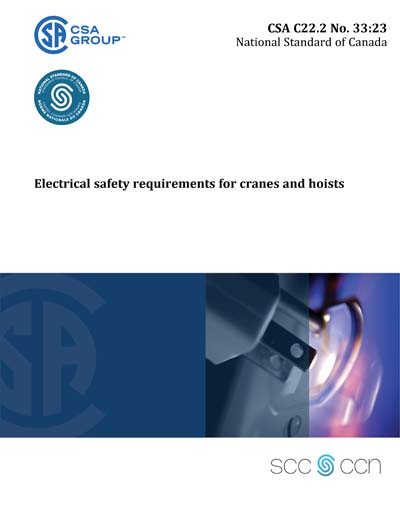Most recent
CSA C22.2 No. 33-2023
Electrical safety requirements for cranes and hoists
Preface This is the fifth edition of CSA C22.2 No. 33, Electrical safety requirements for cranes and hoists , one of a series of Standards issued by CSA Group under Part II of the Canadian Electrical Code. It supersedes the previous editions published in 2019, 1984, 1959, and 1936. The major changes to this edition include the following: a) updated construction requirements for incoming service and feeders; b) changes to special construction requirements for monorail hoists separate from cranes; c) addition of the mould stress relief test for conductor bar systems; and d) added normative Annex A. This Standard is considered suitable for use for conformity assessment within the stated scope of the Standard. This Standard was prepared by the Subcommittee on Electric Cranes and Hoists, under the jurisdiction of the Technical Committee on Industrial Products and the Strategic Steering Committee on Requirements for Electrical Safety, and has been formally approved by the Technical Committee. This Standard has been developed in compliance with Standards Council of Canada requirements for National Standards of Canada. It has been published as a National Standard of Canada by CSA Group. Scope 1.1 This Standard applies to all types of electric cranes, including electric overhead travelling cranes, and hoists for vertical lifting and lowering of freely suspended load for voltages of 750 V and less between conductors. The equipment specified in this Standard is intended for installation in accordance with the Canadian Electrical Code, Part I. 1.2 This Standard applies to the following cranes and hoists electrification systems: a) bare, non-rigid and rigid contact conductors, collector shoes and wheels, and associated fittings; and b) insulated conductor bar assemblies, collector trolley assemblies, and associated fittings (such as splices, power feeds, hangers, end caps, and similar). 1.3 This Standard applies to equipment for general industrial and commercial application, in nonhazardous locations for indoor and outdoor locations. 1.4 This Standard applies to equipment for installation in an ambient temperature not exceeding 40 °C. 1.5 This Standard applies to wireless control equipment used in conjunction with electric cranes and hoists. 1.6 Annex B covers optional requirements for DC drives. Annex C covers optional requirements for contact conductors. 1.7 This Standard does not apply to a) elevators; b) dumbwaiters; c) stairway hoists; d) tower cranes; e) manually operated chain driven cranes; f) mobile cranes; g) draglines; h) mine hoists; i) guided loads; j) below-the-hook attachments; and k) construction cranes and hoists. 1.8 In this Standard, “shall” is used to express a requirement, i.e., a provision that the user is obliged to satisfy in order to comply with the Standard; “should” is used to express a recommendation or that which is advised but not required; and “may” is used to express an option or that which is permissible within the limits of the Standard. Notes accompanying clauses do not include requirements or alternative requirements; the purpose of a note accompanying a clause is to separate from the text explanatory or informative material. Notes to tables and figures are considered part of the table or figure and may be written as requirements. Annexes are designated normative (mandatory) or informative (non-mandatory) to define their application.
Content Provider
CSA America, Inc. [csa]






